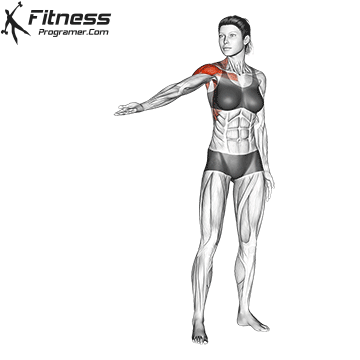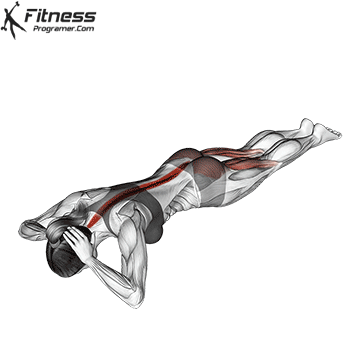How to Bodyweight Windmill
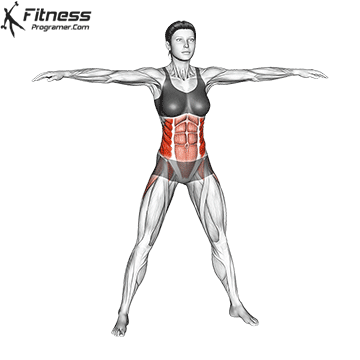
Bodyweight Windmill Benefits
- A dynamic flexibility exercise that you can do before starting workouts. It can help you increase flexibility and range of motion, including back, shoulder, arm, legs and abdominal muscles
Muscles Worked in The Bodyweight Windmill
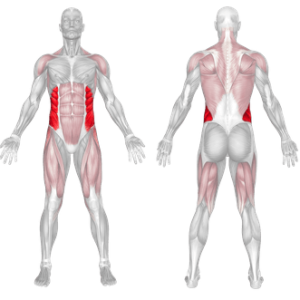
Cable External Shoulder Rotation
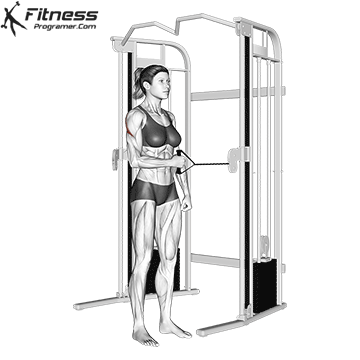
Cable External Shoulder Rotation Benefits
The shoulder muscle consists of 3 parts. These; anterior deltoid, lateral deltoid and posterior deltoid muscles. Besides these large muscles, there are 4 more muscles to consider. These muscles are called rotator cuff muscles. These muscles are like columns under the building! The stronger the columns, the more earthquake resistant the building. The shoulder muscles are just like that, the stronger the muscles that support it, the stronger the shoulder muscles. One of the causes of shoulder pain and shoulder injuries in sports is to overload the shoulder muscles without strengthening these muscles.
- Rotation exercises are exercises designed to strengthen the rotator cuff muscles connected to the shoulder muscles. Strengthening your rotator cuff muscles with these exercises before shoulder training is beneficial for your shoulder health.
- To makeover the entire muscle for better muscle balance and joint stability, you have to work it through a full range of motion. Performing shoulder exercises designed to strengthen the muscles as well as to improve the shoulder range of motion will reduce the stress on the joint making it less susceptible to joint inflammations like tendinitis and bursitis.
Muscles Worked in the Cable External Shoulder Rotation
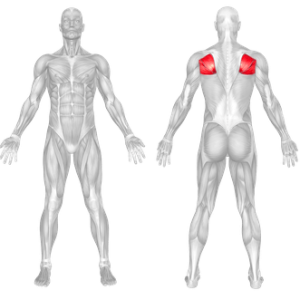
How To Cable Internal Shoulder Rotation
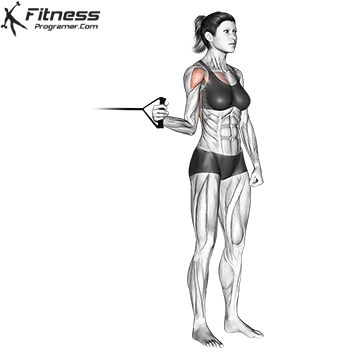
Starting Position: Begin by adjusting a cable machine so that the handle is a little higher than your waist.
Hold the handle and bend your elbow to 90 degrees. Step away from the machine so that there is a little tension in the starting position.
Form: Exhale and rotate your shoulder in towards the center of your body. Hold for a brief second and then slowly lower to the starting position.
Tips: Do your best to keep your shoulder next to your body– don’t let your elbow move too far out to the side.
Move in a slow and controlled manner so that momentum doesn’t take over. Especially focus on slowly returning to the starting position.
Cable Internal Shoulder Rotation Benefits
The shoulder muscle consists of 3 parts. These; anterior deltoid, lateral deltoid and posterior deltoid muscles. Besides these large muscles, there are 4 more muscles to consider. These muscles are called rotator cuff muscles. These muscles are like columns under the building! The stronger the columns, the more earthquake resistant the building. The shoulder muscles are just like that, the stronger the muscles that support it, the stronger the shoulder muscles. One of the causes of shoulder pain and shoulder injuries in sports is to overload the shoulder muscles without strengthening these muscles.
- Rotation exercises are exercises designed to strengthen the rotator cuff muscles connected to the shoulder muscles. Strengthening your rotator cuff muscles with these exercises before shoulder training is beneficial for your shoulder health.
- To makeover the entire muscle for better muscle balance and joint stability, you have to work it through a full range of motion. Performing shoulder exercises designed to strengthen the muscles as well as to improve the shoulder range of motion will reduce the stress on the joint making it less susceptible to joint inflammations like tendinitis and bursitis.
Muscles Worked in the Cable Internal Shoulder Rotation

How to Across Chest Shoulder Stretch
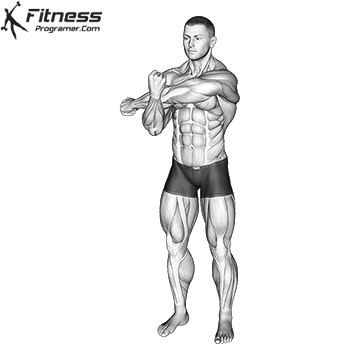
Dynamic stretching consists of active movements. It is usually done before a workout to help warm up your muscles and increase your heart rate. Move slowly, stop and repeat, dig a little deeper each time and improve your range of motion. Pre-workout dynamic stretching improves circulation, prepares your muscles for movement, and temporarily increases your range of motion.
Static stretching, more commonly done at the end of a workout when your muscles are warm, is when stretches are held in place for a certain period of time, not moving. Static stretching is the most effective form of stretching for loosening up your muscles, joints, ligaments, and tendons, while also improving flexibility and range of motion. Static stretching requires you to move a muscle to the end of its range of motion and maintain this position for 20 to 45 seconds. Repeat this 2 to 3 times each.
Across Chest Shoulder Stretch Benefits
- Shoulder stretches can help relieve muscle tension, pain, and tightness in the neck and shoulders. Including shoulder-specific exercises and stretches in your overall workout program may help increase your shoulder mobility and flexibility. These movements may also build strength in your shoulders, improve your shoulder function, and prevent injury.
- In addition, this stretching movement benefits the triceps, and back muscles.
Muscles Worked in the Across Chest Shoulder Stretch
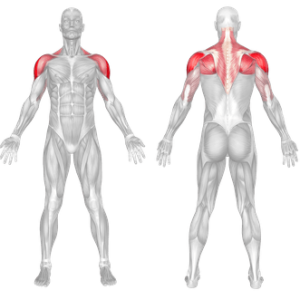
How to: Standing Reach Up Back rotation Stretch
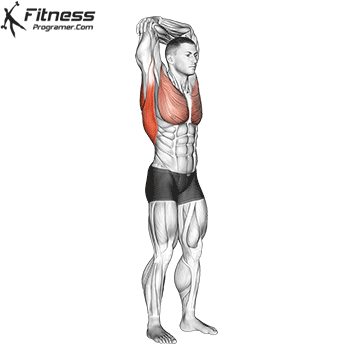
Dynamic stretching consists of active movements. It is usually done before a workout to help warm up your muscles and increase your heart rate. Move slowly, stop and repeat, dig a little deeper each time and improve your range of motion. Pre-workout dynamic stretching improves circulation, prepares your muscles for movement, and temporarily increases your range of motion.
Static stretching, more commonly done at the end of a workout when your muscles are warm, is when stretches are held in place for a certain period of time, not moving. Static stretching is the most effective form of stretching for loosening up your muscles, joints, ligaments, and tendons, while also improving flexibility and range of motion. Static stretching requires you to move a muscle to the end of its range of motion and maintain this position for 20 to 45 seconds. Repeat this 2 to 3 times each.
Standing Reach Up Back rotation Stretch / Benefits
- You can use this exercise to stretch more than one muscle group. Especially while stretching the back muscles, your chest, shoulder and triceps muscles will also gain flexibility. Adding stretches to your overall workout will help increase your muscle mobility and flexibility.
Muscles Worked
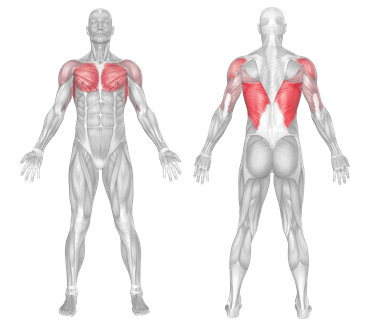
Shoulder Stretch Behind The Back Overview
The Shoulder Stretch Behind the Back is a static stretch designed to improve shoulder flexibility, mobility, and posture. It primarily targets the muscles and joints in the shoulders, while also engaging the chest, upper back, and arms. This stretch is particularly beneficial for releasing tension in the shoulders caused by poor posture, prolonged sitting, or repetitive upper-body movements.
Who Should Perform This Stretch?
- Office Workers: Helps alleviate tension from prolonged sitting and poor posture.
- Athletes and Lifters: Improves shoulder mobility, aiding performance in sports and weightlifting.
- Older Adults: Maintains shoulder health and prevents stiffness associated with aging.
- Individuals in Rehab: Gentle enough for recovery programs, with modifications as needed.
How to perform the Shoulder Stretch Behind the Back
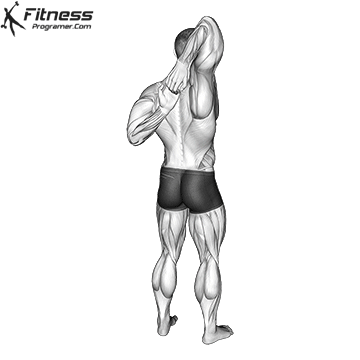
Standing Variation:
- Stand in a neutral posture with your feet shoulder-width apart.
- Raise one arm overhead and bend the elbow to reach behind your back.
- Simultaneously, bring the other arm behind your back from below, aiming to touch or overlap your fingers.
- Do they touch, or are they close to touching? Are they overlapping?Does one side feel tighter than the other?
- Switch sides and note your results.
- Hold a towel or resistance band in both hands behind your back.
- Use the towel to assist in pulling your arms into the stretch if clasping your hands is challenging.
- Follow the same technique as above, ensuring a controlled stretch.
Shoulder Flexibility Test
The Shoulder flexibility test is a simple flexibility test to determine whether the hands can be brought together from behind and to detect shoulder range of motion.
Measure distance from finger tip to finger tip. If fingers overlap, score as a plus. If fingers fail to meet, score as a minus.
- Fingers overlap / Excellent
- Fingers are touching / Good
- Fingertips are not touching but are less than two inches (5cm) apart. / Fair
- Fingertips are greater than two inches (5cm) apart. / Poor
Tips for Maximum Effectiveness
- Start Gradually: Begin with a smaller range of motion and increase as your flexibility improves.
- Pair with Other Shoulder Stretches: Combine this stretch with movements like reverse shoulder stretches or assisted stretches for a comprehensive routine.
- Incorporate into Work Breaks: Use this stretch during long periods of sitting to reduce tension and improve posture.
- Breathe Deeply: Take slow, deep breaths during the stretch to help relax the muscles and enhance flexibility.
Common Mistakes to Avoid
- Overarching the Back: Keep your core engaged to avoid excessive arching in the lumbar spine.
- Hunching the Shoulders: Ensure your shoulders are pulled back and down, rather than shrugged upward.
- Using Momentum: Perform the stretch slowly and with control to avoid jerking motions that can strain the muscles.
- Forcing the Range of Motion: Stretch only to a comfortable point; avoid overextending the shoulders.
Benefits of the Shoulder Stretch Behind the Back
- Improved Shoulder Flexibility
- Enhances the range of motion in the shoulders, making it easier to perform overhead or reaching movements.
- Better Posture
- Opens up the chest and pulls the shoulders back, counteracting the effects of hunching or slouching.
- Relieves Muscle Tension
- Reduces tightness in the shoulders, chest, and upper back, particularly for those with desk jobs or frequent overhead lifting.
- Prevents Injuries
- Increases flexibility and mobility, which can reduce the risk of strains, particularly in sports or resistance training.
- Improves Athletic Performance
- Prepares the shoulders for dynamic movements, benefiting activities like throwing, swimming, or weightlifting.
- Versatility and Accessibility
- Can be performed anywhere, with or without equipment, and is suitable for all fitness levels.
Muscles Worked
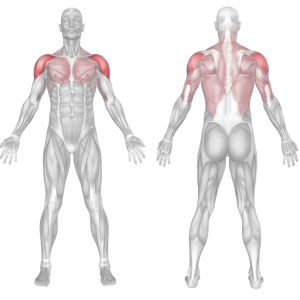
How to Floor Hyperextension
1- Lie face down with your legs together. Place your hands by the side of your head, keeping your shoulders relaxed and your core active. Breathe in.
2- Exhale as you lift your upper body off the floor. Perform the movement slowly, controlling it with your core. Be careful not to jerk your head or strain the muscles of your lower back or neck.
3- Breathe in, hold briefly at the top of the movement, maintaining an active core, then slowly and gently lower yourself back to the start position.
Floor Hyperextension Benefits
- This move strengthens the erector spinae muscles that provide support to the spine. Strong back muscles can prevent postural deviations that lead to poor posture and discomfort, such as kyphosis (“hunchback”). Floor hyperextension movement improves your posture by extending your back muscles and reducing the tension between your lower back and core areas. It also enhances your lower back’s strength, making it easier to stay upright throughout the day.
Muscles Worked in the Floor Hyperextension
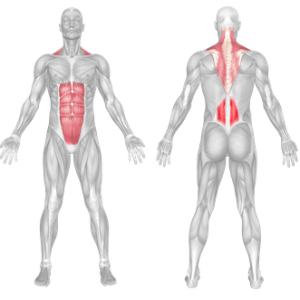
How to Flat Bench Hyperextension
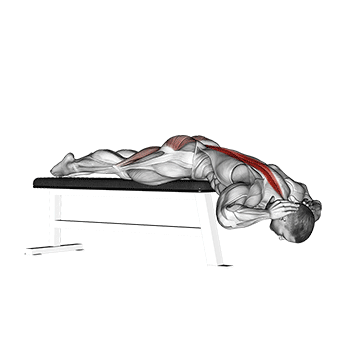
Flat Bench Hyperextension Benefits
- Hyperextension exercises are an excellent workout that strengthens your core, lower back, glutes, and hamstrings.
- Hyperextension movement improves your posture by extending your back muscles and reducing the tension between your lower back and core areas. It also enhances your lower back’s strength, making it easier to stay upright throughout the day.
- It’s also beneficial for lower back health as some lower back pain can stem from weak glutes and tight hamstrings.
Muscles Worked in the Flat Bench Hyperextension
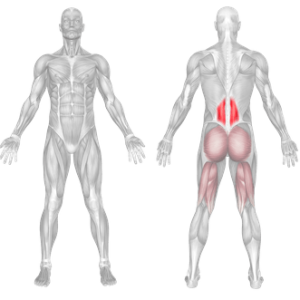
How To: Lying glute stretch
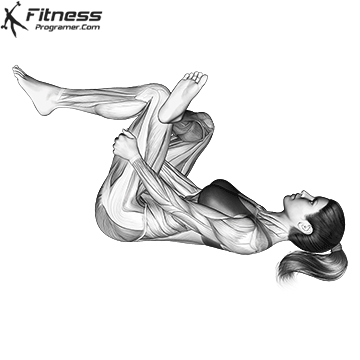
How to do Single Arm Circles
